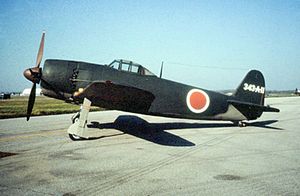Kawanishi N1K2-J Shiden Kai
-
Guns:
-
4 × 20 mm (0.79 in) Type 99 Mark 2 machine guns in the wings.
-
Bombs:
-
2 × 250 kg (550 lb) bombs
or
- 1 × 323 L (85 US gal; 71 imp gal) drop tank
M6A1
Armament
-
Guns: 1× 13 mm cabin-mounted Type 2 machine gun
-
Bombs:
- 1× Type 91 torpedo or
- 2× 250 kg (551 lb) or 1× 850 kg (1,874 lb) bombs
A Kyushu Q1W1
Armament
- 1 × flexible rearward-firing 7.7 mm Type 92 machine gun
- 1 or 2 × fixed forward-firing 20 mm Type 99 cannon sometimes fitted
- 2 × 250 kg (550 lb) bombs or depth charges
Nakajima Ki-27
-
Guns:
-
2 × 7.7 mm (0.303 in) Type 89 machine guns, 500 rounds/gun
-
1 × 12.7 mm (0.5 in) Ho-103 machine gun and 1 × 7.7 mm (0.303 in) machine gun on later models
-
Bombs:
-
4 × 25 kg (55 lb)
-
2 × 130 L (34 US gal; 29 imp gal) drop-tanks
A Mitsubishi G4M2a Model 24 of the 763rd Kōkūtai
Armament
- Guns: 1× 20 mm Type 99 cannon (tail turret), 4× 7.7 mm Type 92 machine gun (nose turret ×1, waist positions ×2, top turret ×1)
- Bombs: 1× 858 kg (1,892 lb) Type 91 Kai-3 (improved model 3) aerial torpedo or 1× 800 kg (1,764 lb) bomb or 4× 250 kg (551 lb) bombs or 1x 1200 kg (2,645 lb) Yokosuka MXY-7 Ohka suicide bomb
Why because Japan needs more planes one of the best air forces of the second world war. While listed as trainers many were later pushed into frontline services. especially when more obsolete planes were repurposed for limited single use aircraft. would love to see at least more tanks and planes fill out the tech tree of the rising sun.





 Kawanishi N1K1-J Shiden “George”
Kawanishi N1K1-J Shiden “George”